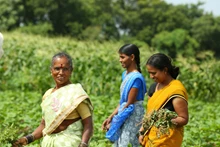
India is facing the harsh realities of climate change, particularly due to global warming, which has led to significant impacts on its weather patterns.
Over the last three decades until 2018, at least five states - Uttar Pradesh, Bihar, West Bengal, Meghalaya, and Nagaland - have experienced a notable decrease in rainfall during the Southwest monsoon season. Additionally, annual rainfall in these states, along with Arunachal Pradesh and Himachal Pradesh, has also shown a significant decreasing trend.
While some states have not witnessed substantial changes in SouthWest monsoon rainfall during the same period, the country as a whole has been experiencing alterations in the monsoon patterns. Unseasonal rainfalls have been occurring during October, November, and March, while heat waves have become more frequent in recent years.
The impact of climate change on Indian weather has begun to affect the country's agricultural production, particularly in the case of wheat and rice, which are staple cereals widely consumed across the nation. The issue of climate change's impact has been raised by experts for some time, but this is the first instance where the government has acknowledged its effects.
The India Meteorological Department (IMD) conducted an analysis of observed monsoon rainfall variability and changes across 29 states and union territories at the state and district levels based on data from 1989 to 2018.
The Minister's statement also highlighted the increasing frequency of heavy rainfall days in specific regions, including Saurashtra and Kutch, southeastern parts of Rajasthan, northern parts of Tamil Nadu, northern parts of Andhra Pradesh, and adjoining areas of southwest Odisha, many parts of Chhattisgarh, southwest Madhya Pradesh, West Bengal, Manipur and Mizoram, Konkan and Goa, and Uttarakhand.
These weather changes and extreme events are in line with the global trend of rising extreme weather events due to climate change caused by global warming. The recent IPCC climate change report suggests that these trends will persist in the future and are inevitable.
To better prepare for such events, the IMD has introduced an impact-based forecast (IBF) that focuses on predicting the effects of severe weather rather than just describing the weather itself.
The IBF provides details about the expected impacts of severe weather elements and offers guidelines to the general public on how to respond to such situations. The forecast also uses a colour-coded system to indicate the severity of the weather event, ranging from green (no warning) to yellow (watchful and updated information needed), orange (alert and prepared to take action), and red (take immediate action). These measures aim to support disaster management activities and help the public prepare for and respond to extreme weather events.











